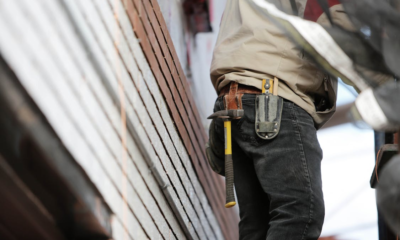Tech
Passivation Process of Stainless Steel Parts
Published
1 year agoon
By
Robert King
Passivation involves the chemical treatment of stainless steel utilizing acidic solutions, which results in forming a passivation layer over stainless steel that effectively impedes corrosion causing chemical reactions, enhancing longevity, and preserving strength. It is a simple yet effective process that can reinforce CNC stainless steel to withstand the worst forms of rust. With passivation, you can make your stainless steel parts completely rust-repellent.
Passivation is a proven game changer for manufacturers. It offers a multitude of benefits to both the manufacturer and users. These include:
- Removal of corrosion during chemical treatment of stainless steel.
- Layered protection against oxidation and other harmful chemical reactions.
- Enhanced lifespan and quality of stainless steel parts.
- Long-lasting corrosion resistance, strength, and durability.
By preventing corrosion, stainless steel’s mechanical strength, structural integrity, and dimensional stability are preserved over time. Moreover, passivation is a low-cost precaution that saves repair and maintenance expenses later. In the long run, it helps you avoid costly repairs, replacements, and downtime associated with steel degradation.
Passivation is emphasized by industrial standards ASTM A967 and AMS 2700, widely used in aerospace, marine, and infrastructure industries.
Detailed Guide to the Passivation Process of Stainless Steel
Passivation of stainless steel can be completed in three simple steps. After process completion, it takes about 24 to 48 hours for the formation of the passivation layer.
As stainless steel is a metal alloy of iron, nickel, and chromium, the passivation layer is nothing but a chromium oxide film on its surface. This film is highly corrosion-resistant and non-reactive to the environment. The passivation process catalyzes the formation of chromium oxide, allowing a thicker layer to form on the surface.
Here is the step-by-step process involved in the passivation of stainless steel:
Step 1: Cleaning Stainless Steel Parts
Passivation starts with surface preparation. Thoroughly clean the surface to remove contaminants or any traces of dirt, oil, etc. Make use of compatible detergents to ensure proper cleaning. If the surface is affected by corrosion, it may require mechanical tools for removal. Be aware of industry standards ASTM A380/A380M and comply with them,
Step 2: Immersion in Passivating Acid Bath
Passivation could be completed using recommended passivation agents like Nitric acid, Nitric acid with sodium dichromate, and Citric acid. Before the acid bath, ensure the solution is thoroughly mixed, and the volume follows the prescribed instructions.

Immerse the stainless steel parts in the solution and ensure the part is completely submerged. Let it rest per the immersion time; it usually depends on the type of stainless steel, the passivation agent used, the condition of the surface, and the desired level of corrosion resistance.
Step 3: Final Quality Testing of Passivated Stainless Steel Parts
Inspection and final quality testing are crucial to ensure the highest quality standards. After process completion, inspect the parts for any signs of discoloration, staining, or other abnormalities. Make use of corrosion testing equipment and other tests according to ASTM A967 for the quality check mentioned below.
- Water Immersion Test
- High Humidity Test
- Salt Spray Test
- Copper Sulfate Test [Not recommended for specific steel grades]
- Ferroxyl Test [Not recommended for specific steel grades]
- Free Iron Test
Remember, passivation is a permanent process. The passivation layer is also affected by environmental factors and mechanical abrasion; hence, it requires regular maintenance and care. For continued protection, the passivation process shall be repeated.
Practices to Increase Quality of Steel Passivation Parts
You can implement various industry best practices to increase the quality of steel passivation parts. You can achieve the highest passivation quality, especially in CNC machining stainless steel using the techniques below;
Using Separate Machining For Stainless Steel
It is observed that contaminants are the root cause of low-quality passivation in stainless steel parts. Therefore, when machining stainless steel, it is recommended to use separate machining equipment. It reduces the chances of impurities being fused in stainless steel, which later affects passivation.
Otherwise, properly clean the equipment for stainless steel CNC machining. Cross-contamination is prevented by implementing separate machining for stainless steel, which later helps improve passivation quality.
Industrial Fluids Quality Checking
Various types of fluid used in the passivation process play an essential role in maintaining passivation quality. However, they are often overlooked and not maintained properly. In order to obtain desired passivation results, it is essential to regularly check the quality and condition of these cleaning and passivating solutions.
Here are the steps to take for quality checking of industrial fluids:
- Periodically analyze the samples of these fluids. Check if they meet the specified standards.
- pH levels of passivating solutions are crucial for the quality; ensure they remain within the recommended ranges.
- Carry out proper filtration or purification processes to remove contaminants from these solutions.
Strict Compliance with Industry Standards
ASTM and AMS have provided regulations and specifications for passivation to maintain quality. These standards must be followed under all circumstances. The passivated stainless steel parts have a wide array of applications in medical, military, aerospace, and infrastructure. Hence, adherence to these standards is mandatory.

- ASTM A967
- AMS 2700
- ASTM A380
- AMS-QQ-P-35
- ASTM F86
- ASTM F983
- ASTM B600
- AMS-STD-753
- BS (British Standard) EN 2516
Conclusion
Passivation helps maximize the performance and durability of stainless steel. The passivation process offers a multitude of benefits in terms of longevity, cost-effectiveness, and reliability. CNC stainless steel parts or other stainless steel machined parts are extensively used in aerospace, medical, and food processing industries. Therefore compromise on passivation quality has grave consequences.
To achieve desired results from the passivation process, you must ensure compliance with set standards, complete the process per the instructions, and use best practices for the highest quality. If done correctly, passivation improves operational efficiency and minimizes downtime, making it a valuable investment.
Recent News


4 Amazing Trips for Your Family
Choosing somewhere for a family vacation that would pique the attention of adults and kids alike can be a fun...


Customising Your Makeup with Blendable Blush Options
In cosmetics, one’s face is a canvas for self-expression and creativity. Among the myriad of products available, blush is a...


The Benefits of Regular Home Maintenance
Regular home maintenance is essential for maintaining and even raising the value of your house. A proactive approach to repairs...


Understanding the Importance of SEO in Adelaide
In the digital marketplace, Adelaide businesses are in a continuous contest to gain the attention of their target audiences. With...


Breaking Down the Numbers: Understanding the Average Traveling Nurses Pay
The open road, adventure, and the chance to heal – travel nursing promises an undeniable allure. But amidst the excitement,...


Dealing with Oily Skin in Summer: Tips and Tricks
As the temperature rises, those with oily skin often face an additional challenge—maintaining a clear and balanced complexion. Excess oil...


Mountain Wedding Ideas for 2024
A mountain wedding is a stunning choice for couples who cherish nature and desire a distinctive wedding experience. Whether you...


3 Of The Best Ways To Keep Your Salon Clean
It is of the utmost importance to ensure that a salon is kept scrupulously clean, not just for the sake...


3 Reasons You Should Get Blood Tests Every Year
Regular blood tests are essential for preserving general health and identifying potential problems early on. Medical professionals can evaluate your...


How to Make Your Next Crafts Project Pop
Crafting is a creative outlet that allows individuals to express themselves through various mediums such as paper crafts, sewing, painting,...
